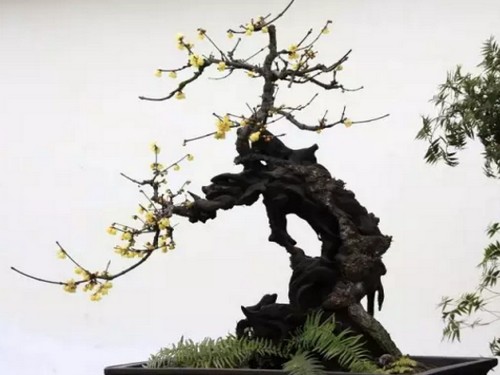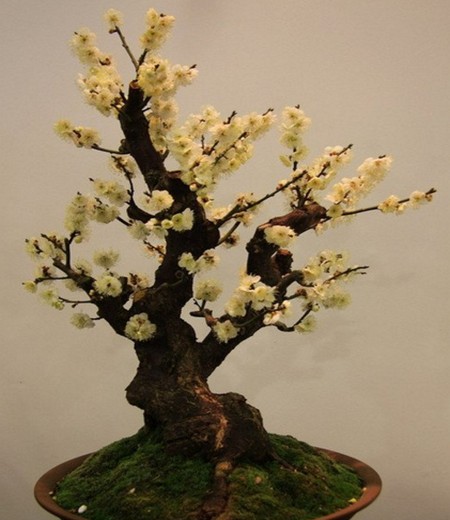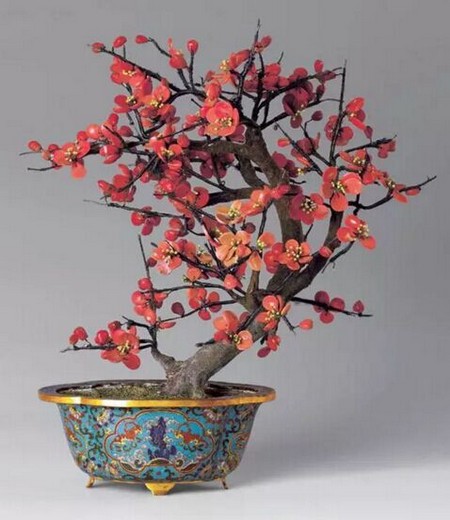Modeling method of Chimonanthus bonsai
In the "hometown of Chimonanthus", Henan Province, the traditional bonsai forms of Chimonanthus include single plum, dragon plum, pimple plum, single hanging plum, double hanging plum, round hanging plum, Pingfan plum, pearl rolling curtain and so on. It can not only be modeled with young trees, but also use old and simple ancient piles of Chimonanthus praecox as rootstock, grafting fine varieties such as Chimonanthus praecox, Chimonanthus untold, whose roots are dilated and in the shape of a pimple, which is called "pimple plum".

As the branches of Chimonanthus are brittle and easy to break, it is not suitable for large-scale bending modeling, generally only brown silk will be used to slightly hang the trunk or branches, and then trim the twigs slightly, generally from May to August, this is because the branches are soft at this time, and attention should be paid to watering before operation to further soften the branches and facilitate modeling operation.
Another traditional technique for making wintersweet bonsai in Yiling is "knife method", which is generally carried out from March to April. The method is on the trunk of the tree, where it needs to be bent at a certain distance from the basin soil, and cut obliquely at the center of the trunk with a knife. The depth is about 2 to 3 of the diameter of the trunk, and then gently bend the trunk down by hand, but do not break it, using the tip of the broken triangular xylem. Against the slope of the face, embed a stone or broken tile in the open space to prevent restoration. After the cut is mudded, it is wrapped in plastic sheeting and then fixed to the support pole, and the thicker trunk can be cut obliquely with a saw. This "knife method" can make the upright trunk form a certain angular curvature, and this method can also be used for thicker branches.
This "knife method" can not only be used alternately at a distance between the two sides of the trunk to make it pitch and twists and turns, but also can be rotated to make the trunk sway left and right to increase momentum. And now more according to the shape of the tree and the idea of the knife shape. The wintersweet bonsai modeled by "knife method" has the characteristics of distinct branches, vigorous and powerful trees and so on.
When making Chimonanthus bonsai, we can refer to the image of Wintersweet and plum blossom in traditional Chinese painting, and put strange stones in the appropriate position of the bonsai according to the modeling needs, so as to increase the quaint and exquisite charm of the bonsai and make it more poetic.
To make wintersweet bonsai, we can choose purple sand pot with good permeability, and the shape of flowerpot can be selected according to the specific shape of tree stump and the different shape of bonsai. Because its flowers are waxy yellow, it is appropriate to choose red-brown, dark blue, dark green and other dark color flowerpots, so that it forms a contrast, but should not choose light yellow pots. Although the glazed porcelain basin is beautiful, but its permeability is poor, it is easy to cause Wintersweet root rot, resulting in poor plant growth and even death, so it can be used as a cover basin.
For the formed wintersweet bonsai, pruning and shaping should be carried out in time after the flower fade to cut off part of the perennial branches and promote the branches to sprout small lateral branches again. The aged branches can also be re-cut according to the shape of the tree to facilitate their renewal and rejuvenation, but pay attention to the position and direction of the terminal buds on the remaining branches. During the growing period, attention should be paid to the new twigs in the current year, so as to promote more branches, change the direction of the branches, make the branches grow stout, breed more buds and blossom more.
In the growing season, for some new branches that need to be bent, hemp rope or brown rope can be used to pull properly, and the necessary pruning should be carried out according to the nature and growth of the tree. After the beginning of autumn, when the flower buds grow to the size of rice grains, a pruning and shaping is carried out to control the excessive growth of branches, so that the plant is compact and the tree shape achieves the artistic effect of sparse shadow and horizontal slope, and it is convenient for the plant to accumulate nutrients and make its flowers large and colorful.
Pruning and sprouting are very important to make Wintersweet blossom year after year. Pruning usually takes place from March to June and stops after August. The old flower branches should be truncated immediately after flowering each year, leaving a maximum length of only 15cm to 20cm. After the new branch grows 2-3 pairs of buds, the terminal bud is removed, and soon the side branch grows again. After growing to 10 cm, the bud is picked again and repeatedly several times until the flower bud is basically formed. It is also necessary to prune all kinds of cross branches, parallel branches, overlapping branches, opposite branches, long branches, and overdense and thin branches that affect the appearance of the tree. It is said that there is no shortage of branches in the flower proverb, so the wax plum can be re-cut.
Time: 2019-06-12 Click:
- Prev

Pruning technique of preserved plum bonsai
Chimonanthus has strong branching power, and it is known as the proverb that Chimonanthus does not lack branches. It can sprout more strong flower branches and blossom more through pruning at the right time. It is generally appropriate to prune the withered branches, overdense branches, cross branches, disease and insect branches, and leave 2 to 3 pairs of buds at the base of the annual branches.
- Next

Fertilization method of preserved plum bonsai
Any kind of plant needs a certain amount of nutrients before it can be cultured well. Although Lamei can withstand the test of severe cold, there should be less fertilizer. In fact, the plum blossom likes a kind of fertilizer very much. Therefore, when raising preserved plum bonsai, we should pay attention to the best choice of fertile land
Related
- Fuxing push coffee new agricultural production and marketing class: lack of small-scale processing plants
- Jujube rice field leisure farm deep ploughing Yilan for five years to create a space for organic food and play
- Nongyu Farm-A trial of organic papaya for brave women with advanced technology
- Four points for attention in the prevention and control of diseases and insect pests of edible fungi
- How to add nutrient solution to Edible Fungi
- Is there any good way to control edible fungus mites?
- Open Inoculation Technology of Edible Fungi
- Is there any clever way to use fertilizer for edible fungus in winter?
- What agents are used to kill the pathogens of edible fungi in the mushroom shed?
- Rapid drying of Edible Fungi

